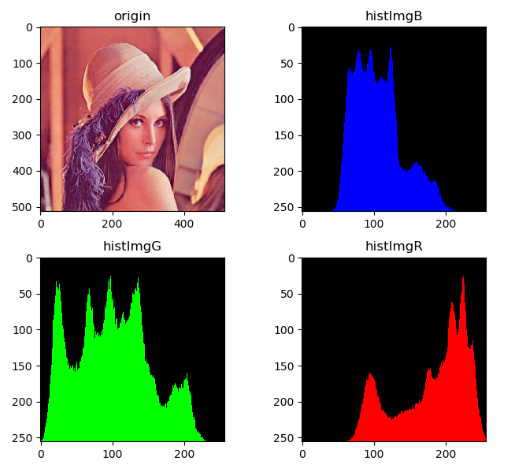本文最后更新于:14 天前
图像直方图
通过灰度直方图看到图像的照明效果
](https://eveseven.oss-cn-shanghai.aliyuncs.com/20190115154350.png)
代码实例
#!/usr/bin/env python
# -*- coding: utf-8 -*-
# @Time : 2019/3/9 21:28
# @Author : Seven
# @File : HistDemo.py
# @Software: PyCharm
# function : 图像直方图
import cv2
import matplotlib.pyplot as plt
import numpy as np
def GrayHist(img):
"""
calcHist(images, channels, mask, histSize, ranges, hist=None, accumulate=None)
images — 源矩阵指针(输入图像,可以多张)。 但都应当有同样的深度(depth), 比如CV_8U 或者 CV_32F ,
和同样的大小。每张图片可以拥有任意数量的通道。
channels — 通道的数量,每个通道都有编号,灰度图为一通道,即channel[1]=0;对应着一维。
BGR三通道图像编号为channels[3]={0,1,2};分别对应着第一维,第二维,第三维。
mask — 掩码图像:要对图像处理时,先看看这个像素对应的掩码位是否为屏蔽,如果为屏蔽,就是说该像素不处理(掩码值为0的像素都将被忽略)
hist — 返回的直方图。
histSize — 直方图每一维的条目个数的数组,灰度图一维有256个条目。
ranges — 每一维的像素值的范围,传递数组,与维数相对应,灰度图一维像素值范围为0~255。
:param name: 命名标志
:param img: 图片数据
:return:
"""
img = cv2.cvtColor(img, cv2.COLOR_BGR2GRAY)
hist = cv2.calcHist([img],
[0],
None,
[256],
[0.0, 255.0])
plt.plot(hist)
plt.xlim([0, 256])
plt.show()
def colorHist(img):
# 颜色直方图
channels = cv2.split(img)
colors = ('b', 'g', 'r')
for (chan, color) in zip(channels, colors):
hist = cv2.calcHist([chan], [0], None, [256], [0, 256])
plt.plot(hist, color=color)
plt.xlim([0, 256])
plt.show()
def channelsHist(img):
b, g, r = cv2.split(img)
def calcAndDrawHist(image, color):
hist = cv2.calcHist([image], [0], None, [256], [0.0, 255.0])
minVal, maxVal, minLoc, maxLoc = cv2.minMaxLoc(hist)
histImg = np.zeros([256, 256, 3], np.uint8)
hpt = int(0.9 * 256);
for h in range(256):
intensity = int(hist[h] * hpt / maxVal)
cv2.line(histImg, (h, 256), (h, 256 - intensity), color)
return histImg;
histImgB = calcAndDrawHist(b, [255, 0, 0])
histImgG = calcAndDrawHist(g, [0, 255, 0])
histImgR = calcAndDrawHist(r, [0, 0, 255])
plt.figure(figsize=(8, 6))
plt.subplot(221)
plt.imshow(img[:, :, ::-1]);
plt.title('origin')
plt.subplot(222)
plt.imshow(histImgB[:, :, ::-1]);
plt.title('histImgB')
plt.subplot(223)
plt.imshow(histImgG[:, :, ::-1]);
plt.title('histImgG')
plt.subplot(224)
plt.imshow(histImgR[:, :, ::-1]);
plt.title('histImgR')
plt.tight_layout()
plt.show()
def grayEqualize(img):
img = cv2.cvtColor(img, cv2.COLOR_BGR2GRAY)
equ = cv2.equalizeHist(img)
# 两个图片的像素分布连接在一起,拍成一维数组
res = np.hstack((img, equ))
plt.figure(figsize=(8, 6))
ax1 = plt.subplot2grid((2, 2), (0, 0))
ax1.imshow(img, cmap=plt.cm.gray)
ax1.set_title('orignal image')
ax1 = plt.subplot2grid((2, 2), (0, 1))
ax1.imshow(equ, cmap=plt.cm.gray)
ax1.set_title('equalization')
ax1 = plt.subplot2grid((2, 2), (1, 0), colspan=3, rowspan=1)
ax1.imshow(res, cmap=plt.cm.gray)
ax1.set_title('horizational')
plt.tight_layout()
plt.show()
def colorEqualize(img):
def hisEqulColor(img):
ycrcb = cv2.cvtColor(img, cv2.COLOR_BGR2YCR_CB)
channels = cv2.split(ycrcb)
print(len(channels))
cv2.equalizeHist(channels[0], channels[0])
cv2.merge(channels, ycrcb)
cv2.cvtColor(ycrcb, cv2.COLOR_YCR_CB2BGR, img)
return img
equ = hisEqulColor(img)
h_stack_img = np.hstack((img, equ))
plt.figure(figsize=(10, 8))
ax1 = plt.subplot2grid((2, 2), (0, 0))
ax1.imshow(img[:, :, ::-1])
ax1.set_title('orignal image')
ax1 = plt.subplot2grid((2, 2), (0, 1))
ax1.imshow(equ[:, :, ::-1])
ax1.set_title('equalization')
ax1 = plt.subplot2grid((2, 2), (1, 0), colspan=3, rowspan=1)
ax1.imshow(h_stack_img[:, :, ::-1])
ax1.set_title('horizational')
plt.tight_layout()
plt.show()
plt.figure()
plt.title("Grayscale Histogram")
plt.xlabel("Bins")
plt.ylabel("# of Pixels")
# 灰度直方图
img = cv2.imread('lena.jpg')
GrayHist(img)
# 颜色直方图
colorHist(img)
# 多通道直方图
channelsHist(img)
# 灰度直方图均衡
grayEqualize(img)
# 彩色图像直方图均衡
colorEqualize(img)灰度直方图

颜色直方图

多通道直方图

灰度直方图均衡

彩色图像直方图均衡

本博客所有文章除特别声明外,均采用 CC BY-SA 3.0协议 。转载请注明出处!